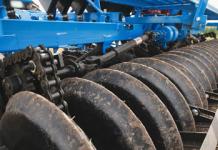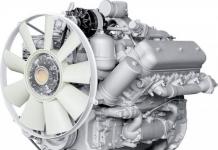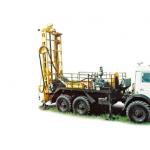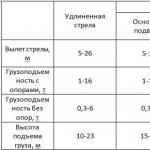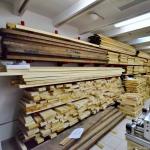Crane KS-5363 is a shooting crane, which has a pneumatic wheel travel. It was developed by the Odessa plant “im. January Uprising" and rolled off the assembly line until 1990. The production of a multifunctional construction crane began in 1970.
With the help of KS-5363, installation and loading and unloading operations with loads not exceeding the maximum allowable weight are carried out at construction sites. A specially designed kinematic scheme allows you to perform several operations simultaneously.
The load capacity is 10 -36 tons, depending on the initial position and modification. Standing on supports, it is able to lift the maximum load, weighing up to 36 tons. Without deployed outriggers, the allowable weight is 14 tons, and with a load of 10 tons.
The main boom lifts the load to a height of 36.2 meters. When using tower equipment with a jib, you can lift the load to a height of 50 meters. The allowed departure angle is 13 degrees.

Crane ks 5363 the following technical features:
- lift the hook at a speed of 7-9 m/min;
- lower the crane at a speed of 0.7 - 9 m / min;
- move at speeds up to 20 km/h;
- withstand the load on the supports up to 324 kN;
- withstand axle load up to 174 kN;
- move 15 tons of cargo on the go.
KS-5363 is equipped with a YaMZ-M204A diesel engine with a capacity of 180 hp. Electric motors have a power of 166 kW. The total weight of the crane is 33 tons. The grab has a capacity of 2 m3.
Basic equipment
The working elements of KS-5363 can be divided into main and replaceable elements. The main equipment consists of a lattice boom and ropes. In addition, there are interchangeable booms, devices with jibs and tower-boom attachments.
The crane is equipped with a main boom, the length of which is 15 meters. The rope used in the boom has a diameter of 21 mm and is 140 meters long. The auxiliary rope has the same diameter, while its length reaches 95 meters.
Replacement equipment
Replacement equipment is installed instead of the main one and allows you to perform other tasks. Depending on this, the technical capabilities of the crane also change.
Replacement equipment consists of the following elements:
- elongated arrows;
- arrows with a jib;
- tower-boom devices.
An elongated boom, an arrow with a jib have a length of 20-30 meters. At one time, the tower-shooting device was only 10 meters. At the same time, unlike the rest of the additional equipment, the tower has a height of 20 meters.

Faucet dimensions
Crane device KS-5363
Pneumowheel crane KS 5363 is a special equipment with several main control systems.
The crane is controlled by:
- mechanical system.
- hydraulic system.
- Electrical system.
The mechanical system is controlled from the remote control. He is responsible for the brake system, gearbox, wheels and supports. When it is necessary to move and stand in a certain place, the driver-mechanic uses this system.
Hydraulic equipment is needed to carry out the lifting and lowering of loads. The main element of this system is the NSh-32E gear pump. In addition, the equipment consists of a hydraulic tank, a pump, an accumulator, turbo lines, and actuator cylinders.
The electric control includes DC generators. One of them carries out the work of the winch and the crane. Another generator works together with a diesel engine and two batteries.
Features of KS-5363
The shooting crane has the following features:
- Maintaining high efficiency with diesel generator.
- Low cost and maintainability.
- Low maintenance and repair cost.
- Possibility of using a grab with a bucket.
- The platform can be rotated even if the boom is not loaded.
- The presence of a pneumatic wheel system increases the controllability of the crane.
- Wheelbase is 2.4 meters, which noticeably improves balance and stability.

Front axle
Hydraulic system
The main element of the hydraulic system is the NSh-32E gear pump. The performance value of this element is 32 l / min, pressure 10.5 MPa. The system begins to operate when oil enters the pump from the hydraulic tank.
The main technical characteristics of pneumatic self-propelled cranes KS-5363 and their electrical circuit are of interest to those who are engaged in performing all kinds of loading and unloading or construction and installation actions at sites located at some distance. This installation performs the lifting of the necessary loads with winches, a rope with a hook clip.
The rotating device of the self-propelled crane is designed so that the swivel structure rotates relative to the static support by moving on roller or ball wheels. The drive of crane mechanisms through the power plant. It is mounted on the chassis of the rotating platform or the rotating part itself. With a large load capacity, the multi-axle chassis is provided with a separate drive with several motors.
Installation device
For all the years of mass production, it was possible to develop and launch the production of various modifications of the crane model KS-5363, which has a pneumatic wheel drive. They differ in letter marking (from A to E).
In the basic configuration, the power plant is equipped with an electric motor, simultaneously with a two-stroke diesel unit, as well as two generators. Scheme of lifting winch kinematics includes an electric motor connected through a clutch to a gearbox, a drum having a ring gear, and brake pads.
The advantages of this crane are already visible from the documentation attached to it:
- The performance of the device is not reduced due to the work with a diesel current generator.
- Maintenance of the installation is available, quite simple.
- It is allowed to use auxiliary devices and blocks during operation.
- The platform rotates when there is no load on the hook.
- Easy motion control.
- Spare parts for repair work are available.
Due to the sufficient remoteness of the wheel bases, the crane balances steadily, ensuring the stability of the structure when performing lifting operations.
Machine description
Crane KS-5363 according to the passport is a diesel-electric design with a lifting capacity of 25 tons. It is equipped with two hooks of mechanisms for the main lifting (25 tons), as well as auxiliary movement (5 tons). The crane also uses a grab with a pair of ropes and a bucket, the capacity of which is 2 cubic meters. m. Used on a crane to increase its load characteristics, a multi-engine drive that feeds an individual power generator set.
![]()
The adjustment of the speed of the actuators occurs along the circuit from the generator to the engine by changing the voltage supplied to the main device that feeds the motor.
When the crane moves without a load, its cabin is allowed to turn. The installation provides a wide range for changing speeds in the movement system not only in working, but also in transport condition. All mechanisms of the equipment are controlled using a mixed drive system.
The operator controls the main mechanisms using a push-button panel and two command controllers. To perform gearshifts, control the wheel turn while driving, outriggers, the truck crane brake system, differential lock, there is pump-type hydraulics.
The differential or supports are controlled using the remote control on the running equipment itself, all other nodes - directly from the operator's cab.
The gear pump ensures the functioning of the hydraulics. Crane winches have rope handlers and spindle end switches. You can extend the main fifteen-meter boom using inserts by 5 or 10 m. The entire installation is equipped with a reliable tower-boom design.
The travel device has two drive axles with dual wheels. There are outrigger telescopic supports on the frame, although the crane, with a small mass of cargo, is able to do without them. Such special support attachments expand the dimensions of the base, increasing it by 0.8 m. The installation can be coupled with a hitch to a tractor that will move it at a speed not exceeding 20 km / h.

If it is necessary to transport the equipment by rail, the boom is removed from it along with the wheels. To load onto a sixty-ton platform, another crane is used, which allows you to lift a load of 25 tons.
Main installation parameters
Several tables summarize the main characteristics of the equipment.
| Minimum | Maximum | |
| Hook reach, if outrigger telescopic supports are not set, m | 3,3 | 25,1 |
| Hook reach when mounted on telescopic supports, m | 2,1 | 7,5 |
| Removal of an arrow from installation, m | 2,5 | 15,9 |
| Likely rise | 13.7 m | 6.4 m |
| Lifting speed, m/min | 7,5 | 9,0 |
| Load lowering speed, m/min | 0,7 | 9,0 |
| Cabin rotation, rpm | 0,1 | 1,3 |
| How fast is the unit moving, km/h | 3,0 | 20 |
| 324 kN | 174 kN | |
| Small radius of curvature of the turn, m | 10,3 | |
| road elevation | 15° | |
| Diesel engine | 180 HP | |
| Motor electric | 166 kW | |
| Wheel track front | 2.4 m | |
| Rear wheel track | 2.4 m | |
| How much does a crane weigh | 33 t | |
| Counterweight, t | 4,0 |
Installation parameters during its movement:
Basic arrow values:
Here you can download for comparison, where, among other things, KS-5363 is also described.
Hydraulic system
The hydraulic drive of such a crane model as KS-5363 is entirely based on the operation of the pumping device of the NSh-32E model. The system is also equipped with a hydraulic tank, cylinders and other components necessary for reliable operation.

Performance is ensured by supplying oil of a certain viscosity from the hydraulic tank to the pump. This pump directs fluid to the cylinders, bypassing the distribution stage of movement. Due to the presence of valves in the cylinders, the required pressure is maintained there. The oil moves the piston.
Chassis
The movement mechanism is provided by creating a torque in several bridges. Each axle (of which there are two in the cart) rotates 4 wheels. To increase the load capacity, hydraulically operated outriggers are additionally installed. Thanks to them, the dimensions of the equipment expand, reaching a parameter of 5 m.

The rear axle ensures the rotation of all wheels. To transport the equipment, either the towing method or the loading of the crane onto the railway platform is used. For the first option, the installation is folded; when loading, it is necessary to remove additional wheels with an arrow.
Hoist Equipment
As structures for the crane modification KS-5363, basic as well as additional devices are provided. The main units include such devices:
- fifteen-meter boom supplied in the kit;
- the main rope of the elongated boom;
- auxiliary rope.

The replacement devices that are included with the installation are as follows:
- replaceable added arrows, allowing to extend the main structure by 5 or 15 m;
- the reach of the interchangeable boom is possible within 5.5–26.3 m.
An arrow is also installed, having a lattice extension. Its flight is capable of reaching a value of 17.1 m.
Management organization
Each of the equipment nodes operates through a mechanical system, adjustable electrical or hydraulic equipment. The first option is implemented by the remote control, which ensures the operation of the wheels, outriggers, brake system, transmission power take-off.
The electric motor powers the winch. The margin of its strength is transferred to the drive axles of the main chassis in the form of an all-welded frame. The hydraulic system provides all lifting operations of the unit.
driver's cab
The frontal zone of the mobile crane cabin is equipped with a dashboard. It contains a pressure gauge with a thermometer, a voltmeter with an ammeter, various levers, and switches. On the sides of this panel are controllers with visual instruments that display power take-off. The steering control of the structure is also located here.

The cabin is equipped with an electric heater, there is an opportunity to warm up the windows in the cold, there are wipers and a fan. The operator's seat is adjustable both in height and in the angle of reclining the back. Since the front (together with the sides) wall is partially glazed, the operator is provided with an all-round view that allows him to observe the operation of the equipment and all units.
The installation has a load capacity limiter brand OGP-1. In order to prevent the lifting height at the hook from exceeding the permissible parameters, a spindle limit switch was used. It is activated when the winch shaft rotates through the set angle.
The gear of such a switch is connected directly to the winch itself. The limiter must be adjusted when the work equipment or the cargo rope is repaired. To prevent the possibility of tilting the loaded boom, the equipment will certainly be provided with a telescopic stop.
electrical equipment
The power plant of the described mobile crane includes:
- Diesel YaMZ-236.
- Starter.
- Two generators producing direct current.

To provide power to the electric motors, which transmit rotation to the movement mechanism simultaneously with the winches, the DK-303B generator operates, producing a final power of 50 kW. Auxiliary generator model P-62 feeds the equipment of control circuits, rotary device, lighting. Its power (passport) is 11 kW.
At the same time, the turning mechanism is able to feed on the main generator. The unit is equipped with DC-only electric motors, which have maximum mechanical strength and are guaranteed to be able to withstand overloads.
The operation of the crane by connecting to an external network is provided by a separate electric motor. To start the diesel engine and provide power to all instrumentation, signaling circuits along with lighting, the unit has batteries that are recharged when the diesel engine is running. They also feed the crane brake light, the ventilation system of the operator's cab.
Due to the presence of a resistor, it is possible to regulate the speed of the electric motor that controls the rotary mechanism. For the remaining motors, the rotational speed is changed by changing the voltage on the main generator. This is done according to the instructions describing the rules for operating the installation.
The operator controls all crane mechanisms using controllers.

To start the switch winch, you need to press the button while moving the handle of such a controller to ensure the boom is raised or lowered. You can slow it down by moving the handle to neutral while pressing the stop button. Turning is also carried out by the controller and the switch that commands the auxiliary generator.
To improve the accuracy of the load during the installation of equipment, the main generator with a winch controller is used. In order to turn right, the handle is placed in the same position as when lifting, to turn left - as when descending. Moving both handles to the "Neutral" position stops the mechanism. It is forbidden to perform the combination of movements when speed control is performed.
Similarly, the movement mechanism is controlled. The engine is started by pressing the "Start" button while smoothly moving the controller handle between positions 1 and 5 to increase speed. Depending on the state of the handle in the “Right” or “Left” positions, the crane moves forward / backward.
Video: in the crane KS-5363.
To increase the speed, you need to perform the following operations: put the controller handle in the neutral position, then set the gearshift knob to the next speed, press "Start", and then smoothly move the controller handle to where you want to move.
To perform electrical braking when the unit is moving, the controller handle must be placed in the neutral position, then press the "Brake" button in turn, while holding it. When you stop pressing the button, the braking system automatically ceases to be blocked.
In order to soften the dynamic braking in a situation where the travel speed exceeds 7 km/h, it is necessary to brake the crane first using the hydraulic brake. Only after such a procedure is it allowed to press the button.
A stop for a short time period is provided by moving the handle to the neutral position, pressing "Stop", and then turning on the brake belonging to the mechanism for moving the installation. When parking for a long time, the parking brake must be used.
Competitive advantages and technical characteristics of the KS-4361A Yurginets self-propelled jib crane with a lifting capacity of 16 tons.
Crane KS4361, KS4361A - diesel single-engine with torque converter. The set of working equipment includes a main boom 10 m long, a hook with a lifting capacity of 16 tons and a grab with a capacity of 1.5 m3, mounted on 10- and 15-meter booms. Interchangeable equipment is elongated booms 15, 20 and 25 m long, obtained from the main boom by inserting 5 m sections, and an uncontrolled jib 6 m long. The boom is equipped with a limiter that prevents it from tipping onto the platform when working at minimum reach
The KS-4361A crane is a modernized model of the KS-4361 crane with a redesigned body and driver's cab. All main characteristics of the crane correspond to the basic model KS4361.

Crane overall dimensions KS-4361A
The running gear of the crane is equipped with outriggers with screw jacks having small shoes at the ends.
On the site, the crane can move under its own power, including with a load on the hook at a speed of up to 3 km/h. Movement with a load on the hook is allowed on the site with a boom of 10 - 15 m directed along the longitudinal axis of the crane.
Over long distances by road, the crane is transported in tow to a tractor using a hitch. In the process of relocating the crane, the gearbox is set to the neutral position, the wheel turning cylinders are turned off, the cardan shaft of one of the axles is removed. The towing speed must not exceed 20 km/h, and on slopes and turns, the speed should be reduced to 3 km/h.
By rail, the crane is transported on a four-axle platform. Before the crane is loaded onto the platform, all pneumatic wheels are removed, the boom sections are disconnected, laying the upper section on the lower one. The crane is loaded onto the platform using an erection crane with a lifting capacity of 25 T. If there are replaceable boom sections, they are placed on the second platform.
Specifications of Mobile Crane KS-4361A
|
load capacity, T: |
|
|
On supports: |
|
|
Without supports: |
|
|
With the smallest hook reach |
|
|
With the longest hook reach |
|
|
hook flight, m: |
|
|
Least |
|
|
largest |
|
|
hook lifting height, m: |
|
|
With the smallest hook reach |
|
|
With the longest hook reach |
|
|
Speeds: |
|
|
lifting the main hook, m/min |
|
|
lowering, m/min |
|
|
Turntable rotation frequency, rpm |
|
|
Self-propelled crane movements, km/h |
|
|
The smallest turning radius (along the outer wheel), m |
|
|
The greatest angle of elevation of the path, hail |
|
|
Engine: |
|
|
Power, hp |
|
|
wheel track, m: |
|
|
Front |
|
|
crane weight, T |
|
|
including counterweight, T |
Lifting capacity during movement and lifting angle to be overcome on the way in the transport position of the crane KS-4361A
*
- The lifting capacity is indicated with the boom located along the axis of the crane.
**
- In the denominator - the permissible angle of inclination of the crane when working on outriggers.
Characteristics of the main and replaceable boom equipment of the crane KS-4361A
Device - pneumatic wheel crane KS-4361A

Crane KS4361A - diesel single-engine with torque converter. The set of working equipment includes a main boom 10 m long, a hook with a lifting capacity of 16 tons and a grab with a capacity of 1.5 m3, mounted on 10- and 15-meter booms. Interchangeable equipment is elongated booms 15, 20 and 25 m long, obtained from the main boom by inserting 5 m sections, and an uncontrolled jib 6 m long. The boom is equipped with a limiter that prevents it from tipping onto the platform when working at a minimum reach.
The KS4361A crane is a modernized model of the KS-4361 crane with a redesigned body and driver's cab. All main characteristics of the crane correspond to the base model KS-4361.
The crane uses a mixed control system - pneumohydraulic. The winch and reverse shafts, as well as the drums, are switched on with the help of pneumochamber clutches; the direction of movement of the mechanisms of rotation and movement of the crane is changed by the reversing mechanism and bevel gears. The inclusion of the reversing mechanism is also provided by pneumochamber clutches. The working speeds of the crane are regulated over a wide range by means of a turbo-transformer fed from the hydraulic system of the crane.

The running gear of the crane is equipped with outriggers with screw jacks having small shoes at the ends. On the site, the crane can move under its own power, including with a load on the hook at a speed of up to 3 km/h. Movement with a load on the hook is allowed on the platform with a boom of 10 - 15 m, directed along the longitudinal axis of the crane.
Over long distances by road, the crane is transported in tow to a tractor using a hitch. In the process of relocating the crane, the gearbox is set to the neutral position, the wheel turning cylinders are turned off, the cardan shaft of one of the axles is removed. The speed of movement in tow should not exceed 20 km/h, and on slopes and turns, the speed should be reduced to 3 km/h.
By rail, the crane is transported on a four-axle platform. Before the crane is loaded onto the platform, all pneumatic wheels are removed, the boom sections are disconnected, laying the upper section on the lower one. The crane is loaded onto the platform using an erection crane with a lifting capacity of 25 tons. If there are replaceable boom sections, they are placed on the second platform.

All the executive bodies of the mechanisms on the KS-4361 crane are set in motion through a turbo transformer 35. Landing of the drums of the boom, cargo and auxiliary (grab) mechanisms - on a common shaft; thus, one three-drum winch was used.
The power take-off from the engine to the compressor 32 is carried out using a V-belt transmission 43 - 44 and a cardan shaft 33. The rotation from the engine 34 to the turbotransformer 35 is transmitted through the clutch 20, the output shaft of the turbotransformer is connected by a chain transmission 15 - 36 with the shaft 9 of the reversing mechanism. The shaft 10 of the three-drum winch is connected to the shaft 9 of the bevel reverse gear 16 - 22 and chain transmission 18 - 23, and the gear 16 and sprocket 23 have a hard fit on the shafts, and the sprocket 18 and gear 22 rotate freely. They are switched on with the help of pneumatic chamber couplings 19 and 14, planted on the shafts. Depending on which gear is engaged (chain or gear), the shaft 10 is given forward or reverse rotation.
As can be seen from the diagram, the boom drum 13, the cargo drum 12 of the main lift and the cargo drum 11 of the auxiliary lift have a free fit on the shaft and are kept from rotating by band brakes. The drums are switched on with the help of pneumochamber clutches; at the same time, the drums are released. Bevel gears 8 freely rotate on the shaft 9, which are in constant engagement with the gear wheel 7 of the vertical shaft 28. By turning on the pneumatic chamber clutches of the gears 8, the shaft 28 is reversed (clockwise or counterclockwise rotation).
The gears 6, the gears 24 and 26 are in constant mesh, and the gear 26 is loosely seated on the shaft. It is turned on with the help of a cam clutch 27, while the shaft 29 starts to rotate. Together with the shaft, gear 25 rotates, rolling along the ring gear 5; the turning part of the crane is rotating. The gear wheel 24, being in constant engagement with the gear wheel 26, also rotates when it rotates, and since the gear wheel 24 is keyed to the shaft 30, the shaft rotates with it. Further, the rotation is transmitted by means of an equalizing clutch to the shaft 31, the bevel gear 45 - 46 and the shaft 55 of the gearbox of the running gear. Gears 4 and 48 rotate freely on shaft 55. They are alternately switched on using a cam clutch 49. Depending on which gear is turned on by the clutch, the rotational speed of shaft 53 changes, and consequently, the speed of the crane.
The gear wheel 51 of the intermediate shaft is in constant engagement with the gear 50 of the output shaft 54, which drives the front and rear axles with the help of cardan shafts 41 and 52.
The front and rear axles of the crane include differential devices that allow the right and left wheels to rotate at different speeds, which is very important when the crane moves along curved sections of the track.
The input gear 40 of the final drive is in constant engagement with the gear wheel 42, sitting on the splines of the intermediate shaft. From the intermediate shaft of the main gear, rotation is transmitted through gears 38 and 39 to the differential housing and through satellites (gears) 3 and sun gear 2 - on the axle shaft of the crane wheels. On the KS-4361 crane with a single-motor drive, when considering the kinematic diagram of its mechanisms, the concepts of the winch of the main and auxiliary lifting are not fully applicable, since the layout of the mechanisms with a single-motor drive does not allow one or another winch to be clearly distinguished; many elements of the kinematic chain of mechanisms are gears for a number of executive bodies. Therefore, on this crane, only the design of mechanisms directly connected with the executive bodies - drums is considered.

Multi-drum winch - KS-4361A.
Three drums are mounted on a common shaft 6: cargo 3, auxiliary (grab) 18 and boom 5. All three drums have a ball bearing fit and rotate freely on the shaft. The drums are turned on with the help of pneumatic chamber clutches 1, 7 and 14, rigidly connected to the shaft, and are kept from free rotation or from rotation under the action of loads (loaded ropes) using band brakes.
The shaft rotates in double-row spherical bearings of supports 2 and 10 and is driven by an asterisk 9 or a gear wheel 11 with a ball bearing support. The wheel is driven by a pneumatic clutch 12. The shaft is reversed by turning on the chain transmission using a pneumatic chamber clutch 19 mounted on the reversing shaft, or by turning on the gear wheel 11.
The principle of operation of the pneumatic chamber clutch is based on the friction of the tire against the surface of the drum pulley under the action of compressed air. Clutch type according to the nature of the connection - friction; according to the nature of work and main purpose - to the class of controlled and coupling clutches, which allow opening and closing the connections of the part.
The clutch consists of a pulley 17, a pneumatic chamber 16 and a tire 15. Air is supplied to the pneumatic chambers through rotating swivel joints from the ends of the shaft 6 (through the channels in it) and from the shaft to the chambers (through flexible hoses). When compressed air is supplied through hose 5 to the chamber, the latter expands and presses the friction band with tire 15 against the inner surface of the drum pulley 3.

Belt brake of cargo and clamshell drums - KS-4361A
The brake band adjoins the outer surface of the drum pulley. Tape 3 consists of two parts connected by a coupling bolt 1. One end of the tape is hinged with a finger on the scarf, the other end is connected to the lug 12. The lug is connected to the rod 7 of the hydraulic cylinder 6 by means of a lever system. The brake control is hydraulic. When you press the pedal of the hydraulic cylinder with your foot, the piston moves to the left and through the rod 7 and the fork 9 turns the lever 11. In this case, the lug 12 moves up and the brake is tightened (the drum is braked). If you remove your foot from the pedal, the piston of the hydraulic cylinder under the action of spring 8 will return to its original position (the drum will be disengaged). Spring 2 is used to uniformly withdraw the brake band from the drum pulley.
A brake of a similar design is installed on the clamshell (auxiliary) drum.

Two band brakes are installed on the boom drum: permanently closed and adjustable. The lug 19 of the permanently closed brake is mounted on the bracket 18; the running end of the brake band is tensioned by spring 4. A ratchet wheel 16 is installed on the drum; with the help of the pawl 15, the drum is kept from rotating. If it is necessary to lower the boom, the pawl is disengaged from the ratchet wheel using the rod 1, the lever 2 and the pneumatic chamber 3. The stroke of the pneumatic chamber rod is limited by the adjustable (screw) stop 17.
The band of the controlled brake, as well as the band of the brake of a cargo winch, consists of two parts connected by a coupling bolt. The uniform departure of the tape from the drum is regulated by the brace spring 6. The brake lug is mounted on the bracket 10 with the help of a roller, on which the lever 12 is also installed, connected at one end to the lug of the brake band 14, and at the other end to the pneumatic chamber rod 9.
The tension of the brake band (braking of the boom drum) is carried out by the spring 8 through the rod 13, the release of the band is carried out with the help of a pneumatic chamber. The main and auxiliary winches of jib cranes are equipped with special devices - rope layers. They ensure the correct laying of the rope in the grooves of the drum and prevent it from coming off the drum.

The turning mechanism is driven by a common engine of all crane mechanisms. The bevel gear 27 of the reverse mechanism of rotation and movement of the crane is in constant engagement with the bevel gears sitting on the reverse shaft. Loads on the vertical shaft 14 are perceived at the top by a deep groove ball bearing, and at the bottom by a thrust ball bearing and a double-row spherical roller bearing. At the lower end of the vertical shaft, a gear 15 is rigidly mounted, which engages with a gear wheel 8, freely seated on a vertical shaft 12. On the shaft 12, in addition to the gear wheel 8, there is a brake pulley 13, a gear clutch 10 and a gear 23; they are all rigidly connected to the shaft. During the rotation of the shaft 14 and when the clutch 10 is off, the gear wheel rotates freely on the shaft 12 and transmits rotation to the gear wheel 7, which is rigidly seated on the shaft 5. Together with the gear wheel 7, the vertical shaft rotates and thus the power is transferred to the movement mechanism.
When the clutch 10 is turned on, the shaft 12 comes into rotation and the gear 23 begins to run around the ring gear 22; the turntable begins to rotate relative to the central shaft 5. The ring gear has an internal mesh.
As can be seen from the diagram, the platform rotation gearbox simultaneously plays the role of a crane movement gearbox. The outer rings 17, 19 are connected not to the frame of the undercarriage, but to the turntable; the inner ring 22 is connected to the fixed frame of the undercarriage. Thus, the inner ring is fixed, it plays the role of the base of the turntable.

Front axle of the crane KS-4361 - controlled, leading; its suspension to the frame is balanced, which improves the adhesion of the wheels to the base on rough roads. The transmission of power from the cardan shaft by semi-axes 12 on the front axle is also carried out by a cylindrical main gear, as well as on the rear axle. The inner wheels are mounted on the hub 6, which is mounted on the pin, reinforced in the housing 17 with the help of tapered bearings. The hub 6 is connected with the axle shaft 4 using the flange 5. The outer wheels are mounted on the hub 2, which is mounted on the hub 6 with the help of plain bearings; thus, the outer wheels are not driven, as they have a loose fit.
When the decrease in patency begins to affect the performance of the crane, the outer wheels are blocked with internal special leashes 18 mounted on flanges 5 so that the protrusion of the leash falls between the stops of the wheel rim. The leash is fixed with a bolt 19. The lower arms of the housings 17 are interconnected by a transverse link 14 of the steering trapezoid. The upper levers of the housings are connected to the rods of the turning hydraulic cylinders, which are mounted on the bracket of the axle housing.
The rotation of the driving wheels from the axle shaft 12 to the axle shaft 4 is transmitted through the articulated joints 15 and 16. The rear axle of the crane KS-4361 is the leading one. The bridge is of an automobile type, its suspension to the frame is rigid. It uses assembly units of the KrAZ vehicle, including the main gear with differential, axle shafts and brakes. Fastening of running wheels - diskless; it is carried out by clamps and rings.
The main gear of the rear axle is cylindrical. The bevel gear is used to connect intersecting shafts and control movement. The movement mechanism of the crane KS-4361 does not have a separate engine of the movement mechanism; power take-off in the gearbox is carried out using a vertical shaft 6 with a bevel gear 7 rigidly planted on it. A bevel gear 4 is engaged with it, rigidly sitting on the input shaft 5 of the gearbox.

Crane brake KS-4361 is mounted on a bracket fixed on the body of the rear axle of the crane.
On the crane KS-4361, between the engine and transmission, instead of the main clutch of the friction type, a special hydraulic device is installed - a torque converter TRK-325. The torque converter provides stepless control of the speed of lifting and lowering the load, reversing the direction of movement, lifting small loads with increased speed, changing the speed of movement depending on the resistance to movement.

The TRK-325 torque converter includes a housing in which the pump 1, turbine 2 and guide 3 (reactor) wheels are tolerably located. The reactor is rigidly connected to the body. The driving pump wheel receives movement from the motor shaft 4, and the turbine (driven) wheel is connected to the driven shaft.
Radiator 5 serves to cool the working fluid passed through it with the help of a gear pump 6. The transformer is provided with a bypass valve, a filter and a hydraulic tank 7, as well as an overrunning clutch. At the same speed of rotation of the turbine and pump wheels, the clutch connecting shafts 4 and 8 is switched on.
Turn off the torque converter by removing fluid from the system. A brake controlled by the driver can be installed on the shaft 8. To direct the movement of fluid in the system, a pneumatic pusher, spool, ejector and diffuser are used.
The pneumatic control system of the KS-4361 jib crane includes the following elements: a compressor, a refrigerator and an oil and moisture separator, a receiver, a control panel with a pneumatic distributor, pipelines and pneumatic chambers mounted on the crane actuators.

The air is pre-compressed in the first stage of the compressor 13, passes through the refrigerator and the oil and moisture separator and is compressed in the second stage to 0.6 - 0.7 MPa, from where it enters the receiver 16 and then through the pipeline 17 to the control panel 3.
In the oil and moisture separator, the air is cleaned of moisture and oil, and then enters the second stage of the compressor. From the control panel, air is supplied through pipelines and special rotating joints 10 to pneumatic chamber couplings 7 of the crane mechanisms.
When each mechanism is turned off, the air from the pneumatic chamber couplings is released into the atmosphere. Special valves 8 are installed in the turbotransformer systems, pneumochamber and brake clutches of the boom drum and the crane movement mechanism for quick braking of the crane mechanisms.
For smooth rotation of the platform in the systems of the reversing mechanism and the rotation brake, as well as the movement mechanism, flow regulators 18 are used. The crane mechanisms are controlled from the remote control with special devices - spools (valves). There are two types of spools: differential and direct acting. Differential spools are used for those crane mechanisms that require regulation of external forces when they are turned on. Such mechanisms are mechanisms with friction clutches used in cranes with a single-engine drive - an internal combustion engine. For mechanisms that do not require a change in pressure in the system, direct-acting spools are used.

The electrical equipment of the crane KS-4361 is used to power indoor and outdoor lighting, light and sound alarms, load limiter; provides start of the starting engine, heating and ventilation of the control cabin, heating of the diesel engine. The source of direct current is the G-66 generator, which is also designed to charge the 6ST-42 battery. The generator is driven by a diesel engine through a gear train.
To regulate the voltage and protect the generator, a relay-regulator is provided, consisting of a voltage relay, a current limiter and a reverse current relay (prevents the battery from discharging to the generator when the diesel engine is not running). Fuses are used for short circuit protection.
The electrical network of the crane during the period of diesel stops is powered by a battery, which is also used to start the starting engine with an electric starter. The value of the charging and discharging current of the battery is determined using an ammeter.
The electrical system of the crane includes a set of converters installed on the engine, oil tank of the turbo-transformer and compressor. These converters make it possible to control the temperature of diesel water and oil, the oil temperature in the turbo-transformer, and the oil pressure in the diesel and compressor systems through appropriate instruments.
The limit positions of the boom are fixed by a limit switch, which acts on the electromagnet circuit. The latter controls the spool, which, when the boom reaches the end position and the switch is activated, turns off the turbo-transformer and turns on the winch brake. The magnet is powered by a running diesel through a relay.
The electrical circuit has a control button that allows you to bypass the limit switch and return the boom to its working position, as well as turn on the load limiter when it is triggered.
A button is mounted on the control panel to turn on the sound signal. A portable repair lighting lamp is switched on through a power outlet.
To limit the lifting capacity of the crane and automatically turn off the cargo winch, an electric load limiter OGP-1 was used. When the crane is operating at minimum boom outreach, a stop with flexible elements is used to avoid tipping it onto the turntable.

Rope traction 2 passes through the deflecting rollers 1 on the boom 4 and is fixed on the platform. Springs 3 support the rope and prevent it from sagging. When the boom reaches the limit angle of inclination (toward the turntable), the rope is stretched and keeps the boom from further movement
Crane KS-5363
Crane KS-5363 (Fig. 46) with a lifting capacity of 25 tons with an individual electric drive is mounted on a special two-axle undercarriage equipped with a towing device and rotary outriggers installed using a hydraulic drive.

Rice. 46. Crane KS-5363, graphs of load capacity (solid lines) and lifting height of the hook (dashed lines) on outriggers and without them for arrows with a length of:
1 and 2 - 15 m; 3 and 4 - 20 m; 5 and 6 - 20 m with a controlled jib; 7 and 8 - 20 m with unguided jib; 9 and 10 - 25 m; 11 and 12 - 25 m with a controlled jib; 13 and 14 - 25 m with unguided jib; 15 to 16 - 30 m; 17 and 18 - 30 m with a controlled jib; 19 - 30 m with an unguided jib (on remote
supports)
Both bridges are leading. The front steered axle has a balancing suspension, switched off during operation by screw stabilizers. Leading at the front axle are the inner wheels, which can be blocked with the outer wheels when driving in difficult road conditions. The slewing bearing is ball, two-row.
The main boom equipment includes a rigid lattice boom. The cargo rope is fixed on the cargo winch, goes around the blocks of the hook clip and the boom head and is fixed on the auxiliary winch. This allows you to control the lifting (lowering) of the load using two winches. The set of interchangeable boom equipment includes rigid elongated booms, elongated booms with jibs and tower-boom equipment. Sections of arrows to reduce the time of their installation are connected using special pins with spring latches. A two-rope grab with a capacity of 2 m3 can be hung on the main boom. Technical characteristics of the crane with the main and replaceable boom equipment are given in table. 18, 26 and 27, The characteristics of the ropes are given in table. 28.
The location of the controls in the driver's cab is shown in fig. 47.
The cabin is equipped with fans, an electric furnace, a windshield wiper and electric glass heaters.
The kinematic scheme is shown in fig. 48. An individual electric crane drive from a power plant consisting of a V diesel engine and two generators: the main VIII supplying the winch electric motors and the movement mechanism, and the auxiliary IX supplying the rotation motor and control circuit. The DK-309B engine with a power of 50 kW was used as the main generator. Auxiliary generator P-62 has a capacity of 11.5 kW.
Diesel V is connected to the main generator VIII by coupling VI. The movement from the generator VIII is transmitted through a four-row V-belt transmission to the compressor VII, the pump IV of the hydraulic control system and the electric motor X brand A2-72-4 with a power of 40 kW. From the electric motor X, the movement is transmitted to the generator IX by a two-row V-belt transmission. Electric motor X drives generators VIII and IX, as well as compressor VII and pump IV when the crane is operated from an external network.
Table 26
Technical characteristics of the crane KS-5363 with elongated booms and tower-jib equipment 
Table 27
Technical characteristics of the crane KS-5363 with elongated booms and jibs 
Table 28
Rope characteristics 

Rice. 47. Location of levers, pedals and control equipment in the cab of the crane driver KS-5363:
1 - button "Movement"; 2 - brake pedal; 3 - sound signal button; 4 - headlight switch; 5 - electric furnace; 6, 7 and 8 - "Stop", "Reverse" and "Start" buttons for controlling the main winch; 9 - left controller; 10 - 13 - buttons "Stop", "Brake 2", "Brake 1" and "Start" of movement control; 14 - pressure gauge of the pneumoenstem; 15 -- indicator panel load limiter; 16 - parking brake control handle; 17 ~ external network buttons; 18 and 9 - "Start" and "Stop" buttons for controlling the auxiliary generator; 20 and 21 - "Start" and "Stop" buttons for controlling the boom winch; 22 - diesel control buttons; 23 - auxiliary generator voltmeter; 24 - oil pressure gauge; 25 - auxiliary generator ammeter; 26 - turn signal switch; 27 - side lights switch; 28 - headlight switch; 29 - turn signal switch; 30 - package switch; 31 - voltmeter of the main generator; 32 - water temperature gauge; 33 - backlight of the control panel; 34 - fans; 35 - wiper; 36 - fuel gauge; 37, 39 and 40 - "Start", "Reverse" and "Stop" buttons for controlling the auxiliary winch; 38 - ammeter of the main generator; 41 - oil pressure gauge; 42 - gearbox control handle; 43 - turn control handle; 44 - right controller; 45 - turn motor switch; 46 - glass heater; 47 - fuel supply control handle; 48 - ceiling light switch; 49 - cabin ceiling switch; 50 - fan switch; 51 - outboard headlight switch; 52 - ammeter; 53 - spotlight switch; 54 - converter switch; 55 - control lamp of the mass switch; 56 - fuse box; 57 - 12 V socket; 58 - relay block OGP-1

Rice. 48. Kinematic diagram of the crane KS-5363:
I - turntable; II - turning mechanism; III - boom winch; IV - pump; V - diesel; VI - coupling; VII - compressor; VIII - main generator; IX - auxiliary generator; X - electric motor; XI - auxiliary cargo winch; XII - main cargo winch; XIII - rear axle; XIV - gearbox; XV - front axle
The crane KS-4361 is based on a special all-wheel drive wheeled chassis equipped with dual pneumatic tires. The production of equipment under the Yurginets trademark began in the 70s. The car is intended for performance of installation and loading works on the open areas, and also in warehouses. Production was carried out at factories in Yurga and Kamyshin.
It is allowed to work equipment with a grab with a capacity of up to 1.5 m³. The working body is installed on an arrow with a length of 10.5 or 15.5 m. The maximum load weight in the bucket is 3700 kg. It is possible to install tower-boom equipment with a construction height of 15 or 20 m. In this case, a controlled boom with a reach of 10.5 m is used on the machine. The listed equipment is not included in the standard delivery.
Technical and lifting characteristics
Overall dimensions of the crane KS-4361A and technical characteristics:

- length - 14500 mm;
- width (with removed supports) - 3150 mm;
- height (with the boom lowered to the transport position) - 3030 mm;
- installation weight - 23700 kg;
- turning radius - not less than 12 m;
- carrying capacity when installing supports - 16 tons;
- carrying capacity without additional supports - 9 t;
- hook lifting height - 4.0-8.8 m (depending on the departure);
- speed of lifting and lowering the load - up to 10 m / min;
- platform rotation frequency - 0.5-2.8 rpm.
Device
The crane is based on a welded frame equipped with 2 bridges. The front steer axle is mounted on an equalizer support, which improves wheel traction on rough roads. Changing the angle of installation of the wheels is carried out by power hydraulic cylinders. The rear axle has a rigid suspension. A 2-speed manual gearbox is mounted in the center of the frame. Cardan shafts are used to transmit torque to the axles. Axle reducers include cylindrical and bevel gears.

On the side beams of the frame there are outriggers equipped with screw jacks. Installation and cleaning of knots is carried out from hydraulics of the crane. The use of supports increases the stability of the machine and contributes to an increase in load capacity. A turntable is installed on the upper surface of the frame, on which all the working units of the machine are mounted. To connect the platform and the frame, a 2-row ball shoulder strap with a ring gear is used.
See » Technical characteristics of the automobile crane KS-2561
Pneumowheel crane KS 4361A is equipped with a diesel power plant, which includes a 75-horsepower atmospheric 4-cylinder unit SMD-14A. The crankshaft of the engine is connected by an elastic coupling with a turbo-transformer, which allows you to smoothly adjust the operating speeds of the machine. Separately from the engine, a pneumatic system compressor is installed. Torque is transmitted by means of a V-belt transmission. A fan is used to cool the compressor.
The transmission consists of cam and gear clutches equipped with a hydraulic drive. The nodes include mechanisms for rotation and movement, respectively. A combined system with a pneumatic and hydraulic drive is used to control the lifting units. The winches are switched on by pneumatic chamber clutches; a similar drive is mounted on a reversing drive. The stop and fixation of the drums are carried out by band brakes.
The standard lattice boom of the crane has a length of 10.5 m; it is possible to install additional extension cords with a size of 5 m (up to 3 pcs.). Additionally, a fixed jib is mounted, having a length of 6 m. When using a jib, the length of the boom is limited to 20 m. At the base of the boom there is a hinge assembly; a protective stop is installed to prevent tipping onto the platform.
The machine has a torque converter designed to drive the working mechanisms of the crane.
A design feature is the installation of boom drive drums, a cargo hook and grab equipment on a single shaft.
The operator is placed in a closed metal cabin. The mechanisms are controlled by levers and pedals.
On a separate order, there are cars with an insulated cab equipped with an autonomous heater. The pneumatic system is equipped with a water vapor separator. The northern version of the crane allows you to work at an air temperature of -60 ° C.
Transportation
Inside the construction site, the equipment moves independently, developing a speed of up to 15 km / h. It is allowed to move with the payload installed on the crane boom. In this case, the assembly is located parallel to the longitudinal axis of the machine; permissible speed does not exceed 3 km/h.

To deliver equipment to the place of work, the method of towing on a rigid hitch is used. Trucks are used as a tractor; the speed of the road train is 20 km/h. When rebasing, the gearbox is transferred to the neutral position, the hydraulic cylinders installed on the controlled axle are turned off. Additionally, the cardan shaft is removed, which serves to drive the front axle.
See » TOP-3 models of domestic erection cranes based on MKT tractors
Delivery over a long distance is carried out by rail. Before loading, the wheels are removed from the machine, the boom is disassembled into component sections. The upper part of the knot is laid on the lower one. Loading is carried out by a crane installation with a lifting capacity of at least 25 tons. If the machine kit includes additional boom elements, they are transported on another railway platform.

